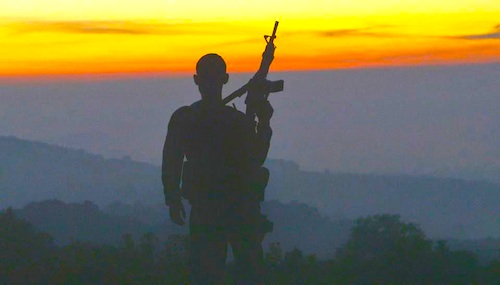By Joe Bendel. Dr. Jose Mireles is like a kindly Mexican Marcus Welby, except he also happens to be the leader of a group of paramilitary vigilantes. Tim “Nailer” Foley more looks the part of a border militiaman, but he shares a common enemy with Mireles. It is not the illegal immigrant per se that concerns him, but the drug cartels running the human trafficking business. Matthew Heineman documents the full scale breakdown of law and order south of the border and some of the resulting implications for American border towns in Cartel Land (teaser here), which screens today as an award winner at the 2015 Sundance Film Festival.
Perhaps the most disturbing thing about “El Doctor” Mireles’ Autodefensas organization is that they operate in the central state of Michoacán, far away from the border. Although Mireles originally attended Autodefensas organizing meetings wearing a mask, he was so recognizable, he simply chose to embrace his role as the group’s public face and spiritual leading. Under his guidance, Autodefensas has been on a roll, liberating town after town from their cartel occupiers. If that sounds like a military campaign, it darn well should.
Meanwhile, Nailer and his Arizona Border Recon group patrol what is known as “Cocaine Alley,” scouring the hills for the cartels’ spotters and traffic directors. Yes, they are also heavily armed. You do not challenge the drug cartels with good intentions and optimism.
Although Cartel Land started out as a project solely about American border patrol groups, Mireles and Autodefensas completely took over the film once Heineman widened the scope. Frankly, it seems like the film is not sure what to make of the Arizona scenes in light of the chaotic drama it documents in Mexico. You can practically feel the film shrug, as if to admit they might have a point.
In contrast, the sequences in Mexico are absolutely harrowing and massively telling. Early on, there is a mind-blowing scene in which an exasperated village rises up against a military unit trying to disarm the Autodefensas. They make it clear, in no uncertain terms, they consider the government to be in league with the cartels. They therefore put their trust in Autodefensas rather than the military. It is stunning stuff, but it should be noted not every village shares this sentiment.
No matter how you feel about the film, you have to give Heineman credit for making it under genuine battle conditions. He was there filming during live firefights, when nobody really knew who was shooting at whom or from where. This is legit war-reporting, just like Sebastian Junger’s Restrepo films.

Cartel Land does not necessarily endorse taking the law into one’s own hands. In fact, many of the scenes in Mexico illustrate the ethical perils of doing so. However, it leaves viewers with no illusions about the complete absence of the rule of law in Mexico today. You can question their on-the-ground tactics, but why it is painfully obvious why Dr. Mireles and his comrades joined together in Autodefensas. Arguably, the film might have been tightened up by editing out more of the Arizona material, but who would want to tell them they ended up on the cutting room floor?
Regardless, Cartel Land is quite an eye-opener as it is. (Since the current president refuses to visit the border, perhaps a private screening can be arranged for him). Recommended for anyone concerned affairs in our hemisphere, Cartel Land screens again today (2/1) as part of this year’s Sundance Film Festival.
LFM GRADE: B+
Posted on February 1st, 2015 at 10:49am.